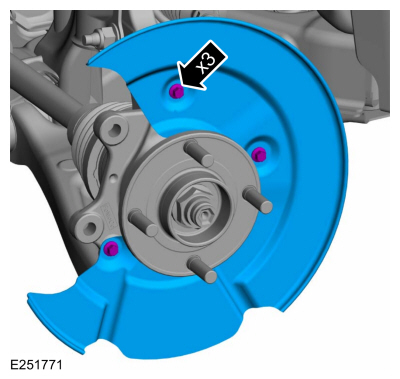Ford Ecosport: Parking Brake and Actuation / Diagnosis and Testing - Parking Brake
Symptom Chart(s)
Symptom Chart: Parking Brake and Actuation
Diagnostics in this manual assume a certain skill level and knowledge of Ford-specific diagnostic practices.
REFER to: Diagnostic Methods (100-00 General Information, Description and Operation).
Check the operation of the parking brake system with the vehicle on a hoist and the parking brake control fully released. Check for damaged cables and install new components as necessary.
The first indication that something may be wrong in the parking brake system is a change in the feeling through the parking brake control. The parking brake not holding on an incline or dragging after being released are also indicators of system concerns.
- Verify the customer concern.
- Visually inspect for obvious signs of mechanical damage.
- If an obvious cause for an observed or reported concern is found, correct the cause.
- If the cause is not visually evident, verify the symptom and go to the Symptom Chart below.
| Condition | Possible Sources | Actions |
|---|---|---|
| The red brake warning indicator is always illuminated |
|
REFER to: Instrumentation, Message Center and Warning Chimes (413-01 Instrumentation, Message Center and Warning Chimes) . |
| The parking brake does not apply/hold vehicle | Rear brake shoes out of adjustment | VERIFY rear brake shoe adjustment, ADJUST as necessary. |
|
GO to Pinpoint Test A | |
| The parking brake will not release |
|
GO to Pinpoint Test B |
Pinpoint Tests
 PINPOINT TEST A: THE PARKING BRAKE DOES NOT APPLY OR DOES NOT HOLD VEHICLE
PINPOINT TEST A: THE PARKING BRAKE DOES NOT APPLY OR DOES NOT HOLD VEHICLE|
Normal Operation and Fault Conditions Diagnostics in this manual assume a certain skill level and
knowledge of Ford-specific diagnostic practices.REFER to: Diagnostic
Methods (100-00 General Information, Description and Operation). When the parking brake control is pulled, the parking brake equalizer pulls on both rear parking brake cables, which are attached to the parking brake actuators, and applies the brake shoes. Possible Sources
|
||||
| A1 CHECK THE PARKING BRAKE CONTROL | ||||
Does the parking brake control move?
|
||||
| A2 INSPECT THE FOLLOWING PARKING BRAKE COMPONENTS | ||||
|
NOTE: Have an assistant pull and release the parking brake to help isolate disconnected cables or cables that do not move.
Is any damage found or are any components disconnected?
|
||||
| A3 ISOLATE THE PARKING BRAKE CONTROL AND FRONT PARKING BRAKE CABLE | ||||
Does the parking brake control handle move?
|
||||
| A4 ISOLATE THE REAR PARKING BRAKE CABLES | ||||
Does the cable slide freely inside the conduit?
|
||||
| A5 ISOLATE THE REAR EXTENSION CABLES | ||||
Does the cable slide freely inside the conduit?
|
 PINPOINT TEST B: PARKING BRAKE WILL NOT RELEASE
PINPOINT TEST B: PARKING BRAKE WILL NOT RELEASE|
Normal Operation and Fault Conditions Diagnostics in this manual assume a certain skill level and
knowledge of Ford-specific diagnostic practices.REFER to: Diagnostic
Methods (100-00 General Information, Description and Operation). When the parking brake release button is pressed and the brake control is released, the tension on the parking brake cables return the system to the released position. Possible Sources
|
||||
| B1 CHECK THE PARKING BRAKE CONTROL | ||||
Does the parking brake control fully release?
|
||||
| B2 ISOLATE THE FRONT BRAKE CABLE | ||||
Do the rear wheel(s) spin freely?
|
||||
| B3 ISOLATE THE REAR PARKING BRAKE CABLES | ||||
Do the wheel(s) spin freely?
|
||||
| B4 ISOLATE THE REAR EXTENSION CABLES | ||||
Does the cable slide freely inside the conduit?
|
 General Procedures - Parking Brake Cable Adjustment - Vehicles With: Rear Drum Brakes
General Procedures - Parking Brake Cable Adjustment - Vehicles With: Rear Drum Brakes
Special Tool(s) /
General Equipment
206-D002
(D81L-1103-A)
Gauge, Brake Adjustment
Cable Ties
Adjustment
NOTE:
LHD shown, RHD similar...
Other information:
Ford Ecosport 2014-2025 Service and Repair Manual: Description and Operation - Exhaust System - Overview
Overview NOTICE: Do not use leaded fuel in a vehicle equipped with a catalytic converter. In a vehicle that is continually misfueled, the lead in the fuel will be deposited in the catalytic converter and completely blanket the catalyst...
Ford Ecosport 2014-2025 Service and Repair Manual: Removal and Installation - Instrument Panel Center Speaker
Special Tool(s) / General Equipment Interior Trim Remover Removal NOTE: Removal steps in this procedure may contain installation details. NOTE: 8 inch display is shown, all other displays are similar. Release the clips and remove the screw cover trim panel...

 PINPOINT TEST A: THE PARKING BRAKE DOES NOT APPLY OR DOES NOT HOLD VEHICLE
PINPOINT TEST A: THE PARKING BRAKE DOES NOT APPLY OR DOES NOT HOLD VEHICLE
